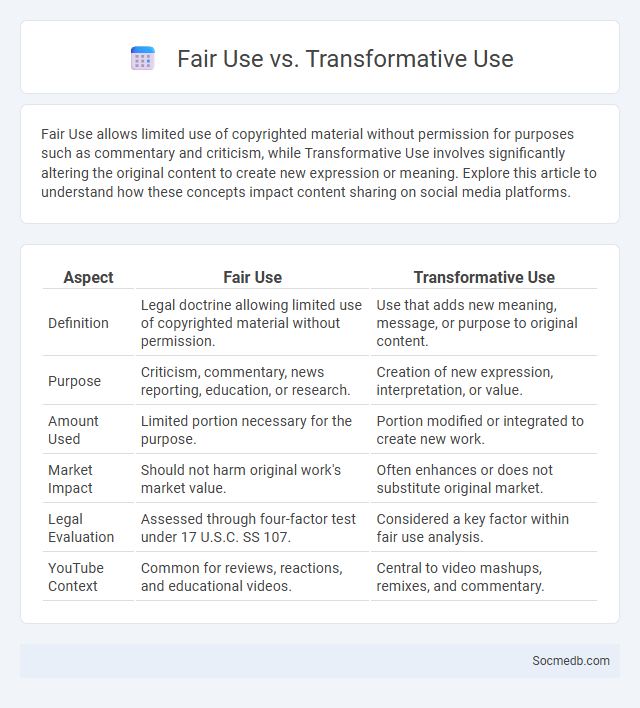
Photo illustration: Fair Use vs Transformative Use
Fair Use allows limited use of copyrighted material without permission for purposes such as commentary and criticism, while Transformative Use involves significantly altering the original content to create new expression or meaning. Explore this article to understand how these concepts impact content sharing on social media platforms.
Table of Comparison
| Aspect | Fair Use | Transformative Use |
|---|---|---|
| Definition | Legal doctrine allowing limited use of copyrighted material without permission. | Use that adds new meaning, message, or purpose to original content. |
| Purpose | Criticism, commentary, news reporting, education, or research. | Creation of new expression, interpretation, or value. |
| Amount Used | Limited portion necessary for the purpose. | Portion modified or integrated to create new work. |
| Market Impact | Should not harm original work's market value. | Often enhances or does not substitute original market. |
| Legal Evaluation | Assessed through four-factor test under 17 U.S.C. SS 107. | Considered a key factor within fair use analysis. |
| YouTube Context | Common for reviews, reactions, and educational videos. | Central to video mashups, remixes, and commentary. |
Understanding Fair Use: Legal Foundations
Understanding fair use is critical for navigating social media content legally, as it allows limited use of copyrighted material without permission under specific conditions. Key legal foundations include purpose and character of use, nature of the copyrighted work, amount used, and effect on the market value. Courts evaluate these factors through landmark cases like Campbell v. Acuff-Rose Music, shaping guidelines that protect creators while enabling transformative content sharing.
What is Transformative Use? Key Differences
Transformative use in social media refers to content that adds new expression, meaning, or message to original material, often through commentary, criticism, or parody, which differentiates it from mere replication. Key differences include the purpose of use--transformative use aims to create something new and socially valuable, while non-transformative use tends to simply redistribute or reproduce content without alteration. This distinction is critical in copyright law as transformative use often qualifies for fair use protection, enabling creators to innovate within the social media landscape.
Fair Use vs Transformative Use: Core Distinctions
Fair Use permits limited use of copyrighted content without permission, emphasizing factors like purpose, nature, amount, and market effect. Transformative Use specifically involves adding new expression or meaning, altering the original work to create something new, which strongly supports fair use claims. Understanding these distinctions is crucial for social media creators to legally navigate content sharing and remixing while respecting intellectual property rights.
The Four Factors of Fair Use Explained
The Four Factors of Fair Use include the purpose of use, the nature of the copyrighted work, the amount used, and the effect on the market value. Social media content creators must balance transformative use, such as commentary or parody, against potential copyright infringement. Understanding these factors helps users navigate legal boundaries when sharing or remixing online media.
Examples of Fair Use in Creative Works
Examples of fair use in creative works on social media include commentary, criticism, and parody, where users incorporate copyrighted materials to provide transformative value. Educational content, such as tutorials or reviews, often qualifies as fair use when it adds new meaning or context without harming the original work's market value. Short excerpts, quotes, or clips are frequently utilized under fair use guidelines to engage audiences while respecting intellectual property laws.
How Courts Interpret Transformative Use
Courts interpret transformative use in social media context by assessing whether the content adds new expression, meaning, or message beyond the original material, which influences fair use determinations under copyright law. Key cases highlight that transformative use is favored when social media posts provide commentary, criticism, or parody, thereby contributing to public discourse and creativity. The degree of transformation impacts the balance between original rights and user freedoms, shaping how content sharing is legally evaluated on platforms.
Common Misconceptions: Fair Use vs Transformative Use
Many people confuse fair use with transformative use, but they are distinct legal concepts in social media content sharing. Fair use allows limited use of copyrighted material without permission for purposes like criticism, commentary, or education, while transformative use involves adding new expression or meaning to the original work. Understanding these differences helps you avoid legal risks and create content that respects intellectual property rights.
Case Studies: Landmark Fair Use and Transformative Use Rulings
Landmark fair use and transformative use rulings have significantly shaped social media content creation and sharing by clarifying the boundaries of copyright infringement. Case studies like the Cariou v. Prince ruling emphasize the court's recognition of transformative use when original works are altered to add new expression, meaning, or message, directly impacting how creators can legally repurpose content. Your understanding of these rulings ensures you navigate social media platforms confidently, respecting intellectual property while fostering creative innovation.
Navigating Copyright Infringement Risks
Social media platforms often face copyright infringement risks due to user-generated content shared without proper authorization. Implementing robust content identification systems and enforcing clear copyright policies are essential for mitigating legal liabilities. Creators and brands must actively monitor their content and utilize digital rights management tools to protect intellectual property effectively.
Best Practices for Content Creators
Content creators should prioritize authentic engagement by responding promptly to comments and fostering genuine interactions to build loyal audiences. Utilizing data analytics to track content performance enables strategic adjustments that enhance reach and impact. Consistent posting schedules combined with high-quality, visually appealing content ensure sustained audience interest and growth across social media platforms.
 socmedb.com
socmedb.com